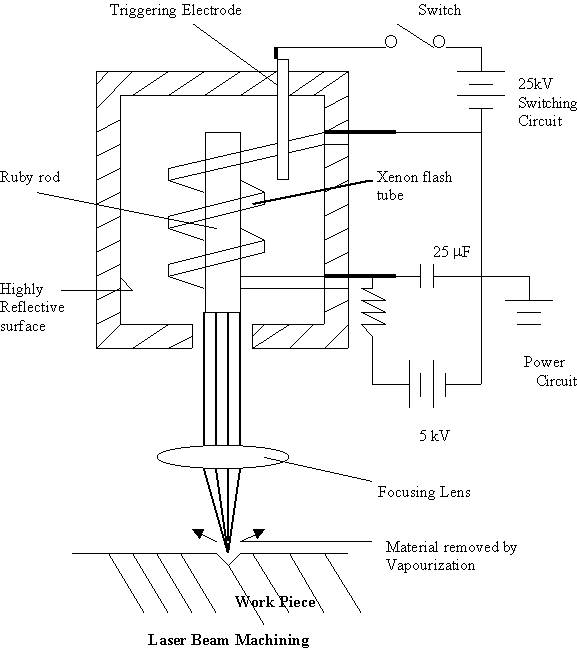
Laser is a highly coherent beam of electromagnetic radiation with wavelength varying from 0.1 – 70 mm. However, from power point of view, effectively usable wavelength range from 0.4 t0 0.6 mm. Rays in laser are perfectly parallel and monochromatic and can be focused on a small diameter producing power density as high as 10 7 w/mm2. For generating high power pulsed ruby laser is used.

A coiled xenon flash tube is
placed around the ruby rod and the internal surface of the container wall is
made highly reflecting so that maximum light falls on the ruby rod for the
pumping operation. The capacitor is charged and a very high voltage is applied
to the triggering electrode to initiate the flash. A lens towards the work piece
surface focuses the emitted laser beam. At the spot where the beam strikes the
surface a small portion of the material is vaporized and ablated at high speed.
The laser emitting system requires proper cooling. Efficiency of LBM is
quite low about 0.3 – 0.5 % . The typical output energy of a laser is 20 J
with a pulse duration of 1 millisecond. The peak power reaches a value of
20000W. The divergence of the beam is about 2 x 10-3 rad and using a lens with a
focal length of 25 mm, the spot diameter becomes about 50m
m.
Laser beam is used to drill micro
holes and cutting very narrow slots. Holes up to 250mm
diameter can be easily drilled by laser. The dimensional accuracy is around ±
0.025 mm. When the work piece thickness is more than 0.25 mm a taper of 0.05 mm
per mm is noticed.
Mechanics of LBM :
Machining by a laser beam is achieved
through the following phases:
I) Interaction of laser beam with work material.
ii) Heat Conduction and temperature rise.
iii) Melting, Vaporization and ablation.
The effect of laser beam in work
piece surface depends on thermo –optic interaction between the beam and solid
work material. So, the work surface should not reflect back too much of the
incident energy. The absorbed light propagates into the work surface and its
energy is gradually transferred to the lattice of atoms in the form of heat. The
absorption is described by Lambert's law as:
I
z = I o e -mz
Here I z is the light intensity at depth
z and m
is the absorption coefficient. Most
of the energy is absorbed in a very thin layer at the surface (typical thickness
0.01mm).
So, it is quite reasonable to assume that the absorbed light energy is converted
into heat at the surface itself and the laser beam may be considered to be
equivalent to a heat flux.
Summary
of LBM Characteristics:
Mechanics of material removal: Melting , Vaporization
Media:
Normal atmosphere
Tool:
High Power Laser Beam
Maximum Material Removal Rate: 5 mm3 /min
Specific Power Consumption: 1000W /mm3/min
Critical parameters: Beam Power Intensity, Beam Diameter, Melting Temperature
Materials Application All Materials
Shape (Job ) Application : Drilling fine holes
Limitations Very large power consumption, cannot cut
materials with high heat conductivity and high
reflectivity